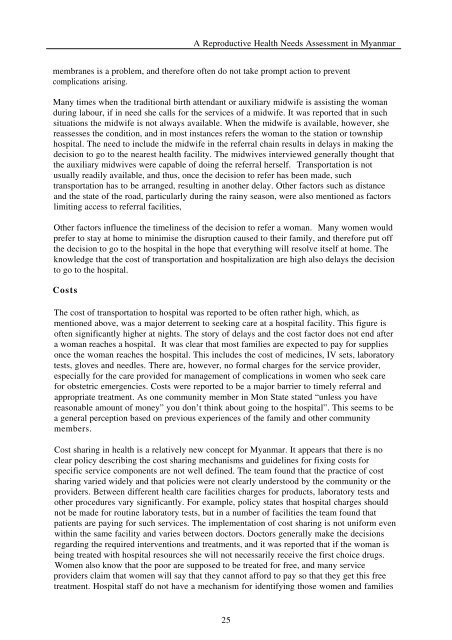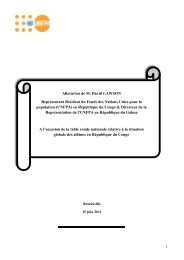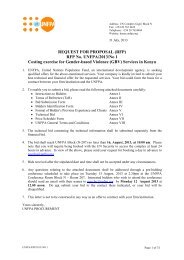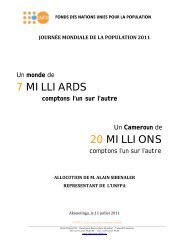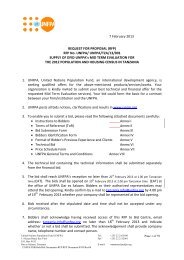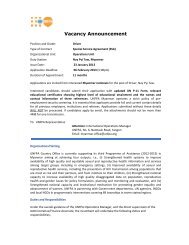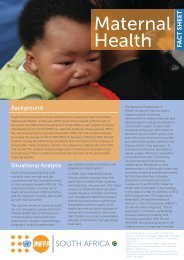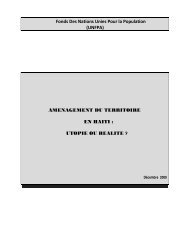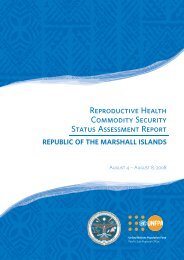A reproductive health needs assessment in Myanmar
A reproductive health needs assessment in Myanmar
A reproductive health needs assessment in Myanmar
You also want an ePaper? Increase the reach of your titles
YUMPU automatically turns print PDFs into web optimized ePapers that Google loves.
A Reproductive Health Needs Assessment <strong>in</strong> <strong>Myanmar</strong><br />
membranes is a problem, and therefore often do not take prompt action to prevent<br />
complications aris<strong>in</strong>g.<br />
Many times when the traditional birth attendant or auxiliary midwife is assist<strong>in</strong>g the woman<br />
dur<strong>in</strong>g labour, if <strong>in</strong> need she calls for the services of a midwife. It was reported that <strong>in</strong> such<br />
situations the midwife is not always available. When the midwife is available, however, she<br />
reassesses the condition, and <strong>in</strong> most <strong>in</strong>stances refers the woman to the station or township<br />
hospital. The need to <strong>in</strong>clude the midwife <strong>in</strong> the referral cha<strong>in</strong> results <strong>in</strong> delays <strong>in</strong> mak<strong>in</strong>g the<br />
decision to go to the nearest <strong>health</strong> facility. The midwives <strong>in</strong>terviewed generally thought that<br />
the auxiliary midwives were capable of do<strong>in</strong>g the referral herself. Transportation is not<br />
usually readily available, and thus, once the decision to refer has been made, such<br />
transportation has to be arranged, result<strong>in</strong>g <strong>in</strong> another delay. Other factors such as distance<br />
and the state of the road, particularly dur<strong>in</strong>g the ra<strong>in</strong>y season, were also mentioned as factors<br />
limit<strong>in</strong>g access to referral facilities,<br />
Other factors <strong>in</strong>fluence the timel<strong>in</strong>ess of the decision to refer a woman. Many women would<br />
prefer to stay at home to m<strong>in</strong>imise the disruption caused to their family, and therefore put off<br />
the decision to go to the hospital <strong>in</strong> the hope that everyth<strong>in</strong>g will resolve itself at home. The<br />
knowledge that the cost of transportation and hospitalization are high also delays the decision<br />
to go to the hospital.<br />
Costs<br />
The cost of transportation to hospital was reported to be often rather high, which, as<br />
mentioned above, was a major deterrent to seek<strong>in</strong>g care at a hospital facility. This figure is<br />
often significantly higher at nights. The story of delays and the cost factor does not end after<br />
a woman reaches a hospital. It was clear that most families are expected to pay for supplies<br />
once the woman reaches the hospital. This <strong>in</strong>cludes the cost of medic<strong>in</strong>es, IV sets, laboratory<br />
tests, gloves and needles. There are, however, no formal charges for the service provider,<br />
especially for the care provided for management of complications <strong>in</strong> women who seek care<br />
for obstetric emergencies. Costs were reported to be a major barrier to timely referral and<br />
appropriate treatment. As one community member <strong>in</strong> Mon State stated “unless you have<br />
reasonable amount of money” you don’t th<strong>in</strong>k about go<strong>in</strong>g to the hospital”. This seems to be<br />
a general perception based on previous experiences of the family and other community<br />
members.<br />
Cost shar<strong>in</strong>g <strong>in</strong> <strong>health</strong> is a relatively new concept for <strong>Myanmar</strong>. It appears that there is no<br />
clear policy describ<strong>in</strong>g the cost shar<strong>in</strong>g mechanisms and guidel<strong>in</strong>es for fix<strong>in</strong>g costs for<br />
specific service components are not well def<strong>in</strong>ed. The team found that the practice of cost<br />
shar<strong>in</strong>g varied widely and that policies were not clearly understood by the community or the<br />
providers. Between different <strong>health</strong> care facilities charges for products, laboratory tests and<br />
other procedures vary significantly. For example, policy states that hospital charges should<br />
not be made for rout<strong>in</strong>e laboratory tests, but <strong>in</strong> a number of facilities the team found that<br />
patients are pay<strong>in</strong>g for such services. The implementation of cost shar<strong>in</strong>g is not uniform even<br />
with<strong>in</strong> the same facility and varies between doctors. Doctors generally make the decisions<br />
regard<strong>in</strong>g the required <strong>in</strong>terventions and treatments, and it was reported that if the woman is<br />
be<strong>in</strong>g treated with hospital resources she will not necessarily receive the first choice drugs.<br />
Women also know that the poor are supposed to be treated for free, and many service<br />
providers claim that women will say that they cannot afford to pay so that they get this free<br />
treatment. Hospital staff do not have a mechanism for identify<strong>in</strong>g those women and families<br />
25


